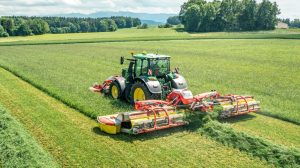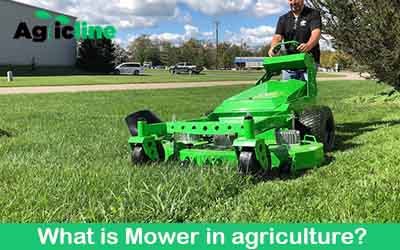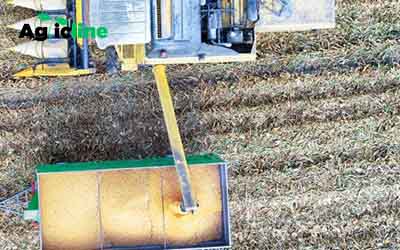In agriculture, a mower is a machine used to cut and harvest standing grass or forage crops.
It is an essential piece of equipment for farmers involved in haymaking, silage production, or pasture management.
The primary function of a mower is to cut the vegetation at a desired height, facilitating subsequent processes like drying, raking, and baling.
Mowers can be attached to a tractor as an implement or operated as standalone machines, such as self-propelled mower-conditioners.
They are typically equipped with adjustable cutting heights to accommodate different forage crops, varying field conditions, and desired stubble heights.
Mowers play a critical role in the initial stage of forage harvesting. They provide a clean and even cut, ensuring that the forage is at an appropriate length for subsequent processes like drying, raking, and baling.
By efficiently and effectively cutting the standing vegetation, mowers contribute to the production of high-quality hay, silage, or pasture for livestock feeding.

Types of Mower
Mowers are available in various types and configurations, including:
Sickle Bar Mower
This type of mower uses a reciprocating blade, called a sickle bar, which moves back and forth to cut the forage.
The sickle bar is attached to a frame and driven by a power source, typically a tractor’s power take-off (PTO). Sickle bar mowers are commonly used for smaller-scale operations or in areas with uneven terrain.
key features and characteristics of a sickle bar mower:
- Blade Design: The sickle bar mower’s cutting blade is curved and serrated, resembling a large sickle or scythe. The blade is attached to a series of guards or fingers that guide the crop towards the cutting edge.
- Cutting Action: The sickle bar moves in a reciprocating motion, driven by a power source such as a tractor’s power take-off (PTO). As the sickle bar moves back and forth, the blades slice through the vegetation in a scissoring action, cutting it close to the ground.
- Cutting Width: Sickle bar mowers come in different cutting widths, ranging from a few feet to several meters, allowing farmers to select a suitable size based on their field size and operational needs.
- Maneuverability: Sickle bar mowers are often designed to be attached to the three-point hitch of a tractor, providing maneuverability and ease of use. They can be operated at various angles, allowing farmers to cut grass in different directions and contours of the land.
- Versatility: Sickle bar mowers are versatile and can be used to cut a variety of crops, including grass, hay, alfalfa, and small grains. They are particularly useful in areas with rough or uneven terrain where other types of mowers may not be as effective.
- Maintenance: Regular maintenance is important for the proper functioning of a sickle bar mower. This includes sharpening and replacing blades as needed, lubricating moving parts, and ensuring proper tension of the sickle bar.
Drum Mower
Drum mowers have cylindrical cutting units with multiple rotating drums equipped with cutting blades.
As the mower moves through the field, the drums rotate, cutting the grass or forage. Drum mowers are known for their high cutting speed and ability to handle dense or thick vegetation effectively.
key features and characteristics of a drum mower:
- Cutting Mechanism: A drum mower consists of one or more horizontally rotating drums equipped with cutting blades. The drums are powered by a tractor’s power take-off (PTO) or a dedicated engine. As the mower moves through the field, the drums spin and cut the vegetation in their path.
- Blade Design: The cutting blades on the drum mower are typically flat and wide, with a slight curve towards the cutting edge. They are arranged in a spiral pattern along the drum’s surface, ensuring a consistent and efficient cutting action.
- Cutting Width: Drum mowers are available in various cutting widths, ranging from a few feet to several meters. The cutting width determines the amount of vegetation that can be cut in a single pass, affecting the productivity and efficiency of the mowing operation.
- Ground Contour Following: Drum mowers are designed to follow the contours of the ground, ensuring an even and consistent cut. They often have adjustable height settings to accommodate different crop heights and desired stubble heights.
- Speed and Efficiency: Drum mowers are known for their high cutting speeds, allowing for fast and efficient mowing operations. The rotating drums create a powerful cutting action, enabling the mower to handle dense or thick vegetation effectively.
- Easy Maintenance: Drum mowers generally have fewer moving parts compared to other mower types, making them relatively easy to maintain. Routine maintenance includes blade sharpening or replacement, lubrication of moving parts, and general inspection for wear and tear.
Disc Mower
Disc mowers feature a set of horizontally rotating discs with sharp cutting blades mounted on them.
The discs rotate in opposite directions, creating a scissor-like cutting action. Disc mowers are popular for their wide cutting widths, ability to handle large fields efficiently, and their ability to produce a clean cut.
key features and characteristics of a disc mower:
- Cutting Mechanism: A disc mower consists of multiple horizontally rotating discs, typically two to four, that are mounted on a cutter bar. The discs are equipped with cutting blades or knives that slice through the vegetation as they rotate. The cutter bar is powered by a tractor’s power take-off (PTO) or a dedicated engine.
- Disc Design: The cutting discs on a disc mower are flat and circular, resembling large saw blades. The cutting blades or knives are mounted along the edges of the discs, typically in a radial pattern. The blades are often reversible or replaceable, allowing for easy maintenance and sharpening.
- Cutting Width: Disc mowers are available in various cutting widths, ranging from a few feet to several meters. The cutting width determines the amount of vegetation that can be cut in a single pass, affecting the productivity and efficiency of the mowing operation.
- Maneuverability: Disc mowers are typically attached to the three-point hitch of a tractor, providing maneuverability and ease of use. They can be adjusted for various cutting angles, allowing farmers to cut in different directions and contours of the land.
- Ground Contour Following: Disc mowers are designed to follow the contours of the ground, ensuring an even and consistent cut. They often have a suspension or floatation system that allows the mower to move up and down independently of the tractor, minimizing damage to the cutting blades and providing a clean cut.
- High Cutting Speed: Disc mowers are known for their high cutting speeds, making them suitable for larger-scale operations where efficiency and productivity are crucial. The rotating discs create a powerful cutting action, enabling the mower to handle thick or dense vegetation effectively.
- Easy Maintenance: Disc mowers generally have fewer moving parts compared to other mower types, making them relatively easy to maintain. Routine maintenance includes blade sharpening or replacement, lubrication of moving parts, and general inspection for wear and tear
Parts of Mower in agriculture
A mower consists of several key parts that work together to cut and harvest grass, hay, and other forage crops. Here are the main parts of a typical mower:
Cutter Bar
The cutter bar is the main component of the mower that houses the cutting mechanism. It is a long metal bar that runs horizontally across the front of the mower. The cutter bar holds the cutting elements, such as blades or discs, and is responsible for the actual cutting of the vegetation.
Cutting Elements
- Blades: Blades are commonly used in sickle bar mowers and disc mowers. They are attached to the cutter bar or rotating discs and are responsible for cutting the vegetation as the mower moves through the field. Blades may be flat, curved, serrated, or triangular, depending on the mower type and manufacturer.
- Discs: Disc mowers feature rotating discs with cutting knives or blades mounted along their edges. The discs spin horizontally and slice through the vegetation as they come into contact with it. Discs are often flat, circular metal plates.
Skids or Shoes
Skids or shoes are metal plates or runners located at the bottom of the mower on either side of the cutting mechanism. They help to maintain a consistent cutting height by gliding along the ground and providing support for the mower.
Suspension System
Many mowers, especially disc mowers, are equipped with a suspension system to allow the cutter bar or discs to follow the contour of the ground. The suspension system helps the mower adapt to uneven terrain, ensuring an even and uniform cut.
PTO (Power Take-Off)
The power take-off is a drivetrain component that transfers power from the tractor to the mower. It connects the tractor’s engine to the mower’s cutting mechanism, enabling the blades or discs to rotate and perform the cutting action. The PTO is typically driven by a rotating shaft.
Three-Point Hitch
The three-point hitch is a linkage system that connects the mower to the rear of the tractor. It provides stability and allows for easy attachment and detachment of the mower. The three-point hitch also allows the operator to adjust the cutting height of the mower.
Drive System
The drive system transfers power from the tractor to the cutting mechanism. It typically includes a gearbox or belt system that connects the PTO to the cutter bar or rotating discs, transmitting rotational motion and power.
Safety Features
Mowers often include safety features to protect the operator and prevent accidents. These may include shields or guards to cover the cutting mechanism, safety switches, and warning decals.
How to get a quality mower
To get a quality mower for your agricultural needs, consider the following steps:
- Determine your specific requirements for the mower. Consider factors such as the size of the area to be mowed, the type of vegetation to be cut, the terrain, and your budget.
- Conduct thorough research on reputable brands and models of mowers. Look for manufacturers with a good reputation for producing high-quality equipment. Read product reviews, seek recommendations from other farmers or agricultural professionals, and compare features, performance, and durability.
- Determine your budget for the mower and ensure it aligns with your requirements. Keep in mind that investing in a quality mower upfront can save you money in the long run by reducing maintenance and replacement costs.
- Visit local dealerships or authorized retailers that sell agricultural equipment. Discuss your needs with the sales representatives and ask for their recommendations based on your requirements and budget.
- Examine the features, build quality, and components of the mowers you are considering. Look for sturdy construction, durable materials, and reliable components.
- If possible, request a test drive or demo of the mower to assess its performance, maneuverability, and ease of use. This hands-on experience will give you a better understanding of the mower’s capabilities and whether it meets your specific needs.
- Review the warranty provided by the manufacturer and ensure it covers essential components and offers adequate duration. Inquire about the availability of service support, including maintenance, repairs, and the availability of spare parts.
- If you’re unsure about which mower to choose or have specific technical requirements, consider consulting with an agricultural equipment expert or a trusted mechanic who specializes in mowers.
Since your opinion counts on our platform, feel free to air your view in the comment box below.



